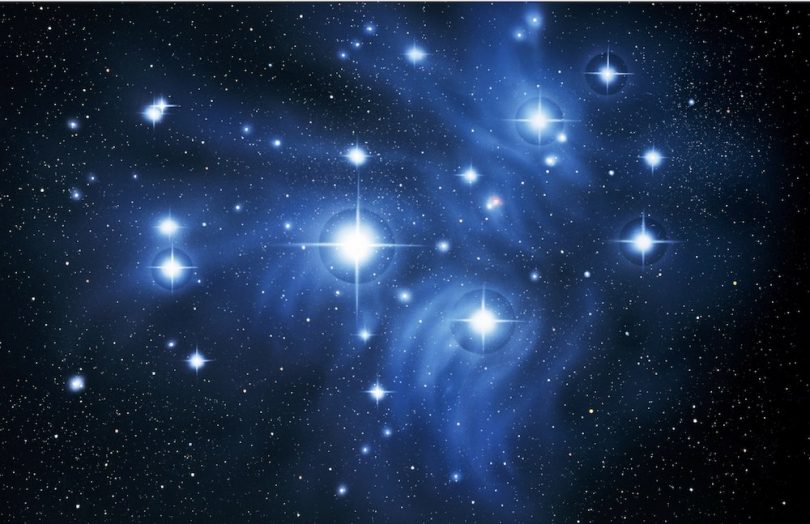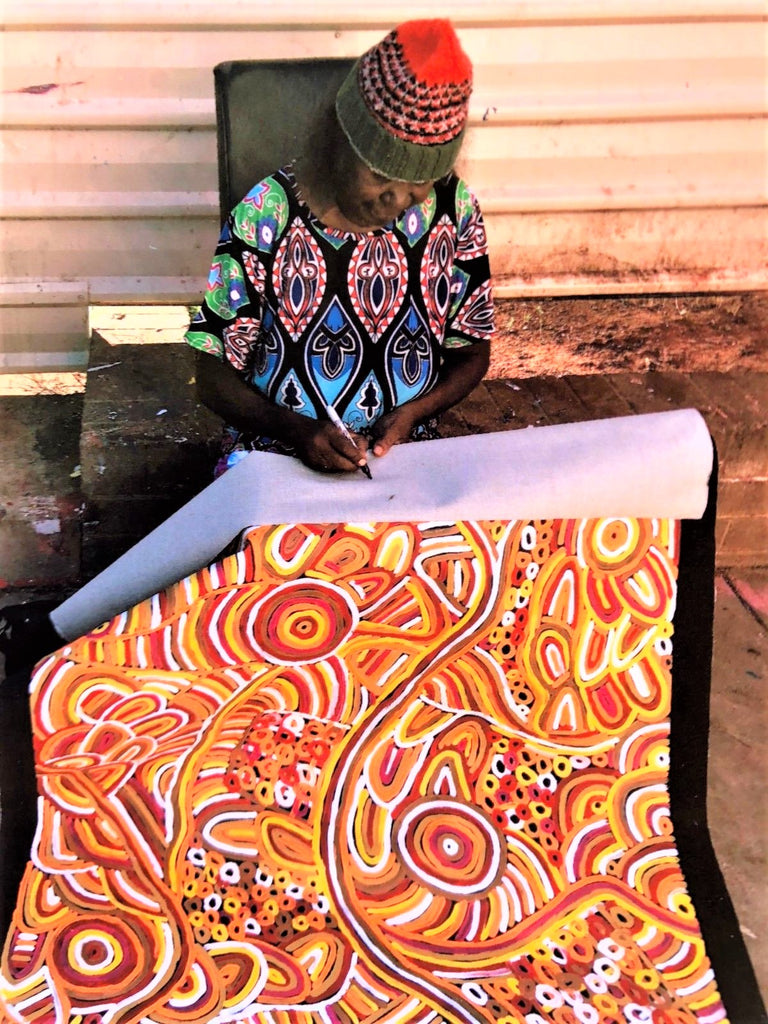News / Aboriginal art
The Story of the “Seven Sisters”
Few stories capture people’s imagination like that of the “Seven Sisters”.
The Seven Sisters Story is told by aboriginal people all over Australia. The stories vary from area to area, but one common factor is that the Seven Sisters are always watchful or running away from the unwelcome advances of a male (Orion).
In NSW, the sisters are called Mayi-mayi. Mayi-mayi were chased by a man called Wurunna. He succeeds in catching two of the women by using trickery. Eventually they escape and rise up into the sky forming the star constellation we know as Pleiades.
In the Kimberley area, the Seven Sisters were chased by the Eagle Hawk. He pursued them into the heavens where we now know the women as the star constellation called Pleiades and the Eagle Hawk as The Southern Cross.
In the Lake Eyre area, the ancestor male who tried to capture one of the women was prevented by a great flood.
In Central Australia, the women (who formed Pleiades) had been up in the sky for some time. They decided it may be safe to come back down to Earth. They made camp in a sheltered cave surrounded by a grove of wild figs. Nirunja, the man of Orion, saw them leave and followed them down to Earth. He made a screen to hide behind and from here he could watch the women without being seen. That night when the women went to sleep he entered the cave and wanted to lie down with them. But the women woke and once more they escaped him by going up into the sky. He, Nirunja, followed. He continues to pursue them in the heavens as the star constellation Orion. On a clear night you can look up into the sky and see Pleiades and Orion close by. He will never give up.
There are many myths about the Seven Sisters, and this story forms an important part of women’s ceremonies all over Australia.
Indigenous Art or Aboriginal Art?
The words ‘Aboriginal’ and ‘Indigenous’ are both used in Australia to describe the original inhabitants of the Australian continent. The word ‘Aboriginal’ is the established way to describe the first inhabitants, regularly used in contexts of Aboriginal community, Aboriginal health, Aboriginal art etc. ‘Aboriginal’ is also used as a noun, so a person is an Aboriginal as well as an Aborigine, which seems to be used less often in the media.
As the term ‘Aboriginal’ is the established way to describe first inhabitants in Australia, we then extend that to ‘Aboriginal and Torres Strait Islanders’ to cover all first inhabitants on Australia and its northern islands. Maybe the use of ‘Indigenous’ has come into use as a term to cover all these groups, and ‘Indigenous Art’ has perhaps come into use with it. It is certainly a term that we associate with use in North America, where we hear of the first inhabitants of Canada and USA described as ‘Indigenous Nations’.
But it seems that there are political aspects to the use of the word ‘Indigenous’ in Australia, as governments have incorporated the word into government department names and into policies. Zoltan Kovacs writes on language use in his Opinions column in the West Australian. In his article ‘In the beginning there were…Aboriginals’ in the West Australian on 25-26 January 2014, Zoltan Kovacs writes –
“The word ‘Indigenous’- written with a capital first letter and used as a substitute for ‘Aboriginal’ – has gained mysterious prominence in everyday language over the past 10 years or so. It is hard to see what benefit people who prefer it to Aboriginal find in its use.
Indeed it has the disadvantage of being essentially an adjective, though the Macquarie Dictionary surprisingly lists its use as a noun with the definition of ‘an Aboriginal or Torres Strait Islander’. It seems impossible to use it as a noun without doing violence to the language… Further ‘Indigenous’ has no plural, which is a severe impediment to its use as a noun.
On the other hand, the use of ‘Aboriginal’ as both adjective and noun and in the singular and plural forms has been well established for generations. Of course if there were evidence of a preference by Aboriginal communities for the use of Indigenous, then that should be a powerful argument in its favour. The evidence is to the contrary.
The State Government changed the name of the Department of Indigenous Affairs to the Department of Aboriginal Affairs last year as a result of what it said were the requests of the WA Aboriginal community and consultations with Aboriginal people. The change was made without evident dissent.
A WA Aboriginal leader of accomplishment, Robert Isaacs, has taken the matter further by telling Prime Minister Tony Abbott that many Aboriginal and Torres Strait Islander people object to the collective description of them as Indigenous. He wrote to Mr Abbott that he, ”as an Aboriginal person and Noongar Elder”, supported their objection to the term, which was increasingly used by government agencies. He argued, in essence, that the term robbed Aboriginal people of their identity.
A reasonable conclusion to be drawn from his letter is that Aboriginal communities are entitled to a sense of grievance if the decision to identify them officially as Indigenous was made without their views being sought and considered. Further it is undeniable that Indigenous is a neutral, bland word without traditional associations…it fails to capture and reflect the unique standing of an ancient people who were the first occupants and custodians of this land.
The word Aboriginal symbolically conveys this history and tradition and can be used respectfully. It is a name by which descendants of the first people of this country are known worldwide. After all, it is made up mostly of the word original.”
In a nutshell, the term ‘Aboriginal’ is so closely associated with Australian first inhabitants that it will remain the principal descriptor for all things associated with Australian Aborigines.


